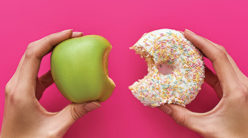Everyone wants a quick fix. A quick checkout. A quick teller. A quick commute. And we treat dieting no differently. When we decide to lose weight, we want to do it quickly. Talk show host Oprah Winfrey was a good example of this when she went on a liquid diet and lost some 60 pounds. But she and everyone else who watched saw the pounds come back.
“That’s because quick fixes lead to quick failures,” says Crystal Whitten, a registered dietitian from the Loma Linda University Department of Nutrition in Loma Linda, California. “Body weight is subject to the laws of nature. One cannot fool nature. Losing weight does not guarantee success. However, women (and men) constantly choose to participate in weight-loss programs that almost always are more harmful than helpful, because weight loss is not purely fat loss.”
Whitten explains: “Weight loss is a combination of fat and muscle loss. It is the loss of muscle that mitigates long-term success. Even if one is participating in a weight-training program during weight loss, there will be some loss of muscle mass. It is the muscle mass that is the primary determinant of one’s metabolism. As muscle size is lost, one’s metabolism drops.”
What about the Zone Diet or the Atkins Diet? “Most diets, including the Zone Diet, Atkins Diet, and others like them, are all temporarily successful,” Whitten admits, “not because they are low in carbohydrates, but because they are hypocaloric (low in calories)! They also always encourage regular exercise.”
And the high-protein diets? “The high-protein diets are some of the most unhealthy diets for many reasons,” Whitten asserts. “They’re popular because they target the American emphasis on protein. But high-protein diets have been implicated in heart disease, osteoporosis, obesity, and many other chronic disease conditions found in the United States.”
Health consultants have capitalized on America’s need for the quick fix. One researcher and health consultant, Dr. Barry Sears, published a book in 1996 called The Zone: A Dietary Road Map to Lose Weight Permanently, Reset Your Genetic Code, Prevent Disease, and Achieve Maximum Physical Performance. He considers his plan a lifelong lasting weight-loss program based on a simple, nonrestrictive diet that links food to hormone “switches” in the body.
Helene Siegel reviewed the book in September 1995 for the Los Angeles Times. In her review she wrote, “Sears makes mincemeat of the USDA food group pyramid, scoffs at juicing, skips the psychology, and then tells people exactly how to eat in order to lose weight: 40 percent carbohydrate, 30 percent fat, 30 percent protein. He is strict, he is rigid, and he outlaws rice cakes and carrot sticks.”
“The problem with that is Sears is giving all of us permission to not eat foods that we have typically seen as `health foods,'” Whitten remarks, “and many of us are all too eager to ditch the rice cakes, carrot sticks, and low-fat cookies. Actually,” she continues, “the American diet is closer to the Sears plan than it is to the USDA recommendations. The average American consumes around 45 percent of calories from carbohydrate. That’s not much different from Sears’ recommendation. This has led to a steady increase in the percentage of adults who are obese.
“Eliminating things like rice, carrots, potatoes, peas, and corn is actually unhealthy,” Whitten adds. “There is no benefit to eliminating the food groups that are the only sources of foods rich in antioxidants and phytochemicals–fruits, vegetables, and whole grains. Sears claims that we can control our insulin secretion by what we eat, but just the action of eating and food in the gastrointestinal tract stimulates insulin secretion.”
Still, Sears stands behind his program, and many must be following, because he’s written two more books, Mastering the Zone: The Next Step in Achieving SuperHealth Permanent Fat Loss (January 1996) and The Anti-Aging Zone (January 1998).
The Borders Bookstore online service describes Mastering the Zone and specifically Sears as “flying in the face of conventional dietary thinking.” Sears claims that after years of comprehensive scientific research he has discovered that “eating doesn’t make you fat.” Borders follows their description of Sears’ book The Anti-Aging Zone as a book that “examines the hormones that affect how we age, from eicosanoids to nitric oxide, serotonin to HGH, DHEA to melatonin, and estrogen to corticosteroids.”
When asked about Sears’ latest book, Whitten warns, “To my knowledge, Sears has never published any peer-reviewed article that would support his view. He takes others’ research and uses bits and pieces to draw a big picture! His program works only because it is hypocaloric and encourages exercise. Beyond that there is nothing to promote. Any claim he makes regarding his program and hormones is completely unscientific and purely speculative.”
So how do we lose weight and still be healthy? “The best way to lose weight is not to gain weight,” Whitten concludes. “Adopt healthy behaviors such as regular exercise, eating healthy foods such as fruits, vegetables, whole grains, legumes, nuts, and seeds, and supplement your meals with low-fat dairy products. That’s all one needs for a healthy diet that can be part of any weight loss program.”
It goes back to the old saying, “If it sounds too good to be true, it probably is.”







1 thought on “Fad Diets: Help or Hype?”
lilly
(June 21, 2010 - 8:02 am)No specifice diet is effective to any specific individual. So most of the time, I wouldn’t think of diets as fad.
Comments are closed.